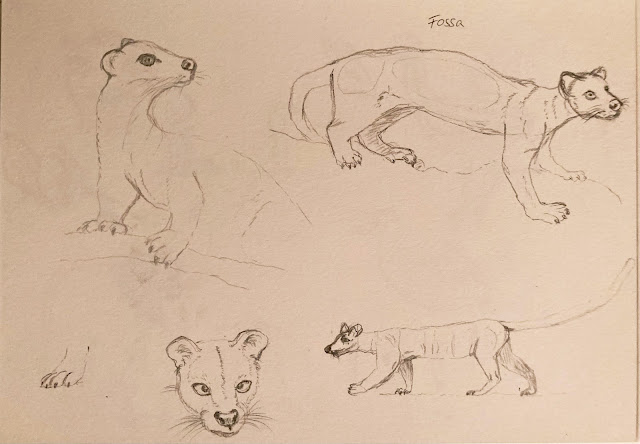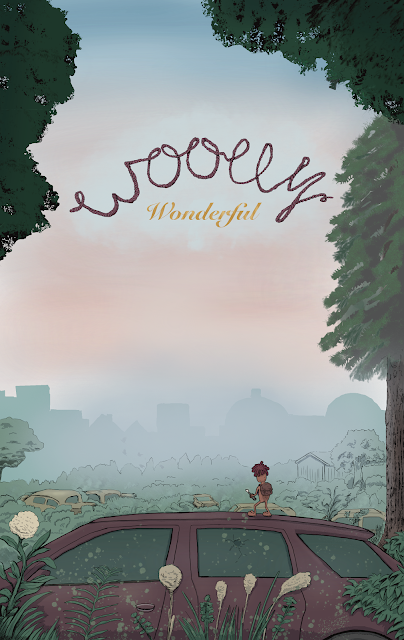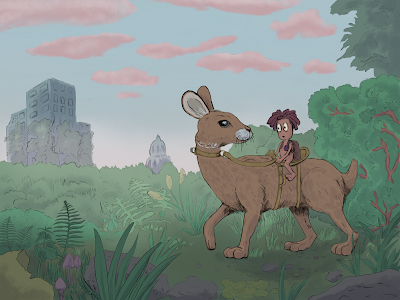Animal Advent Calendar - 2nd Advent
This week I posted sketches for the letters B - H of my Animal Advent Calendar on Instagram. Today, the day of the second advent, you will find these sketches in this blog post. Have fun reading!
B like Bush Dog
Bush dogs are 30cm tall predators from South America with short legs and a long body. They mostly hunt large rodents and armadillos in their forest or savannah habitat. They live in large groups, have several pups per litter, can have young several times a year and fear no natural predators. Sounds like a pretty decent survival strategy.
However, due to residential and commercial building and consequent habitat loss, their prey has less and less space to live. Thus, bush dogs have fewer amounts of animals to prey on. They are also threatened by diseases spread by domestic dogs roaming their territories. These factors resulted in a near threatened classification by the IUCN.
C like Cape Buffalo
Cape buffalos were even more wide spread in the past but at the end of the 20th century, the rinderpest has decimated 90 percent of the population. In the following century more diseases like the mouth-and-claw disease has decimated their counts further. Although numbers are higher up today, they still suffer from the same diseases as cattle does, plus their habitat is shrinking due to more and more farm land using up natural spaces.
D like Dik-Dik
E like Emu
Emus are large ratites, related to ostriches, from Australia and the biggest bird on that continent. As a change to most to the animals I list, they are actually not threatened at all but the subspecies that roamed Tasmania is now extinct.
They are and were considered a pest as they feed on crops. This even led the Australian government to conduct a war on Emus in late 1932. Spoiler: the Emus won. Somehow. Almost a thousand animals got killed, though it was minimal compared to the overall population.
F like Fossa
Fossas are the main villain in the movie Madagascar and all the lemurs fearing them do rightly so. Fossas are the top predator on the island, eating every other animal including lemurs as big as them. This makes the Fossa a key species in their environment, keeping the ecosystem healthy by controlling the population numbers of their prey.
As that island has separated from mainland Africa at the times of the dinosaurs, the common ancestor of the Fossa could be tracked down to an animal that swam from Africa to Madagascar around 20 million years ago.
They only live in Madagascar like 90% of the animals there too. Only around 2,500 individuals are left and since the populations are separated, they are an endangered species, as this leads to a less varied genetic pool.
Man, I love Madagascar and it needs to be preserved.
G like Golden Poison Dart Frog
Poison dart frogs got their name from the fact that indigenous people used their poison in darts to hunt. The frogs accumulate poison in their bodies by eating ants and other invertebrates.
If they are kept in a zoo they won’t have any poisonous abilities.
There are around 200 species of frogs, many of them are threatened with extinction unfortunately. The main issue is a fungus infecting their skin for a few decades which is new to the regions of Mid and South America. It probably was unintentionally introduced through world wide trade and travel.
H like Hammerhead Shark
Hammerheads are not just one but actually 10 species, the biggest being the Great Hammerhead, reaching 6 metres in length.
Their peculiar head shape is the most recognisable feature, serving different purposes at once. First it enhances their view and gives them a hydrodynamic shape, so they can move their heads sideways quickly catching for fish. Secondly it helps them to pin down prey like rays before biting them. And lastly, it enhances the size of their electro sensors in their noses to detect prey buried in sand. Very handy.
They are threatened by deliberate fishing and finning practices or ending up as by-catch and getting thrown overboard leaving them to their death.
Sharks in general are important key stones for a healthy ocean ecosystem, eating sick fishes and mid-sizes predators.
If sharks are missing, other predators can reproduce too much resulting in eating more of the fish that we humans are aiming to catch and consume.
More sharks = more fish to eat
-----
What is Animal Advent Calendar? For every day in December until the 26th I will post a picture of animal sketches on Instagram for every letter of the alphabet.
Come back on the next advent for the next batch of animals. Check out Instagram for daily posts: https://www.instagram.com/andi_pasti_art/
Stay curious,
Andi Pasti










Comments
Post a Comment